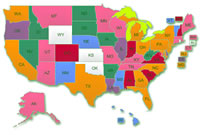What is your net worth? Quite simply, it’s what you have minus what you owe, your assets less your liabilities.
Your assets include your cash, stocks, bonds, and other investments, including your home, plus furniture and furnishings, clothes and jewelry, cars, and even the heirloom ring your mother handed down to you from your great-great-grandmother. Professional appraisals can be a big help if you have expensive items that you need to list on your insurance policy. For our purposes here, though, estimates of value are just fine.
Assets can be considered liquid or illiquid. Liquid assets can be easily converted into cash. For example, a savings account is a very liquid asset. All you have to do is go down to the bank (or the ATM) and withdraw your money. Other investments, such as stocks and bonds, can be liquidated quickly, even if you may miss out on some appreciation.
Illiquid assets, may take some time (and may cost you some money) to convert into cash. For example, you may have $50,000 in equity in your house, but to get your cash out you’ll either have to take out a home equity loan or sell your home. That can take some time, and may be expensive to accomplish. Other examples of illiquid assets include retirement assets and, of course, your personal stuff.
What do you owe? Many of us have credit card debt. You might also have school loans, car loans, mortgages, personal loans you owe to friends or relatives, and business loans.
Pinpointing your net worth gives you a snapshot of your financial life today, which you can use to gauge your progress over time. Once you’ve crunched the numbers, your net worth lets you evaluate the way you spend and save your money. If you find that you’re right on track, yay! If you’re shocked to see how low the number is, knowing your net worth can be a motivational wake-up call.
By creating a net worth computation, you can also evaluate how secure your financial position is. For example, if you have $1 million in total assets, you will probably feel rich. But if only $10,000 is in cash, what happens if you get laid off? And if offsetting that $1 million in assets is $999,000 in liabilities, your wealth won’t last long. You know that you need to make some changes.
Use the worksheet below to create your current financial snapshot.
|
Your Current Financial Snapshot |
||
| Assets | ||
| Cash Bank accounts, CDs, money under the mattress, cash under the sofa cushions, etc |
__________ |
|
| Stuff Cars, jewelry, art, computers, furniture |
__________ |
|
| Retirement assets Money in 401(k)s, IRAs, SIMPLEs, SEPs, TSAs, pensions |
|
|
| Your home and other real estate |
__________ |
|
| Investments Mutual funds, stocks, bonds, value of business, cash value of life insurance |
__________ |
|
TOTAL ASSETS |
__________ | |
| Liabilities | ||
| Debts Credit card debts, car loans, student loans, mortgages, other payments due |
__________ |
|
| Drum roll, please! Subtract Liabilities from Assets. This is called “YOUR NET WORTH” |
__________ | |











